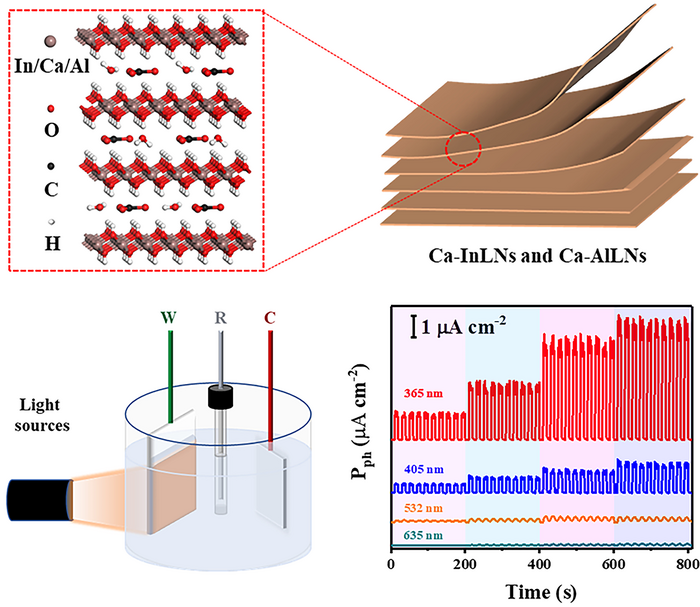Layered double hydroxides are 2-dimensional nanomaterials with several uses in a variety of industries. They can be made in a lab or found in nature, and each has unique qualities that can be applied in many ways.
 This diagram shows the makeup of the nanosheets, how the photoelectrochemical photodetector device is constructed, and changes in the photocurrent density. Image Credit: Nano Research
This diagram shows the makeup of the nanosheets, how the photoelectrochemical photodetector device is constructed, and changes in the photocurrent density. Image Credit: Nano Research
They have been extensively researched and employed, for instance, in supercapacitors, electrocatalysis, photocatalysis, drug delivery, and water purification.
The characteristics of the nanomaterials can be altered to enhance and broaden their applications. To produce layered double hydroxide nanosheets for optoelectronics—electronic devices that interact with light—scientists evaluated new production techniques. Their findings were released on August 5th, 2022, in Nano Research.
This study is significant since it is challenging to make layered double hydroxides in large numbers, uniformly, and with a wide range of light absorption using present techniques.
It is still difficult to prepare a large number of layered double hydroxide nanosheets with a specific thickness, and thickness is closely related to the properties of 2D nanomaterials. Additionally, most of the reported layered double hydroxide materials cannot respond to longer-wavelength light, which limits their application in photodetectors.
Wei Feng, Study Author and Professor, School of Materials Science and Engineering, Tianjin University
Due to these restrictions, scientists set out to discover a method for mass-producing layered double hydroxide nanomaterials with the ideal thickness and a wider spectrum of light absorption.
Researchers can take these variables into account and produce vast quantities of the nanomaterials for use in photoelectrochemical photodetectors that do not lose strength after 70 days using the innovative methods described in this study.
Feng added, “Photodetectors are widely used in detection, imaging, and remote sensing, and they are devices that convert electrical signals into optical signals with very practical application prospects.”
With the help of this study, photodetectors based on stacked double hydroxide nanosheets could be feasible. Considering that photodetector sensors are used in a variety of real-world applications, such as fiberoptic communications, safety monitoring, industrial process control, and biomedical research, this new approach could have an impact on many different sectors.
“Photoelectrochemical photodetectors have very practical application prospects. However, only a few studies have reported photodetectors based on layered double hydroxides and there is no relevant research on layered double hydroxide-based photoelectrochemical photodetectors,” stated Feng.
Researchers were able to effectively mount the layered double hydroxide nanosheets to photoelectrochemical photodetectors and demonstrate a response to light using the completely innovative methodology utilized in this study.
Specific phosphides are heated to form a crystal structure with alternately positive and negative layers to manufacture the nanosheets. The nanosheets are given structure as a result. The layered double hydroxide nanosheets are created when the heated phosphides are placed in air and given time to gradually react with water and carbon oxides.
The thickness, light-absorbing capacity, and resistance to high temperatures of the nanosheets were then studied. The outcomes firstly demonstrated that the nanosheets made using this technique are highly uniform in size, they are typical semiconductors, and their nanosheet structures were extremely stable at high temperatures. Cycling stability was another topic of investigation.
Feng further added, “Cycling stability is an important metric for evaluating device performance. Compared with photochemical photodetectors made of other 2D nanomaterials, whose photocurrent density shows varying degrees of attenuation during long-term cycling testing, the photodetectors made out of these nanosheets exhibit excellent cycling stability.”
This study also included contributions from Yu Wang, Fulai Zhao, and Yiyu Feng of the Tianjin University School of Materials Science and Engineering.
This study was funded by the China Postdoctoral Science Foundation (No. 2021M702424), the National Key R&D Program of China (No. 2016YFA0202302), the State Key Program of the National Natural Science Foundation of China (No. 52130303), and the National Natural Science Foundation of China (Nos. 52103093 and 52173078).
Journal Reference:
Wang, Y., et al. (2022) Ultrathin layered double hydroxide nanosheets prepared by original precursor method for photoelectrochemical photodetectors. Nano Research. doi:10.1007/s12274-022-4778-4.